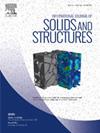应变梯度问题复杂结构强c1耦合多斑块等几何拓扑优化
IF 3.4
3区 工程技术
Q1 MECHANICS
International Journal of Solids and Structures
Pub Date : 2025-02-07
DOI:10.1016/j.ijsolstr.2025.113256
引用次数: 0
摘要
本文提出了一种新的强c1耦合多补丁等几何拓扑优化框架,专门用于解决由四阶偏微分方程(PDEs)控制的应变梯度问题,包括应变梯度弹性和挠性电效应。该方法通过在patch接口重构基函数,实现了多patch域的c1 -连续性,保证了一阶导数的无缝匹配。通过对具有应变梯度弹性和不具有应变梯度弹性的单片域和多片域进行结构分析和优化,验证了该方法的有效性。系统地研究了c1锁定现象,该现象归因于补丁界面上的过度约束解空间。基函数的阶提升通过提供足够的自由度有效地减轻c1锁定。此外,优化框架结合了先进的滤波技术来处理多补丁配置的非结构化网格。邻域滤波稳定性好,但计算成本高,而亥姆霍兹偏微分方程滤波效率更高,但需要仔细调整以减轻振荡行为。通过涉及应变梯度弹性连杆和带圆形孔洞的柔性电梁的优化的案例研究,证明了该框架的实际效用。这些例子突出了该框架在解决复杂工程挑战方面的潜力,提供了更流畅的解决方案,减少了应变梯度弹性中的应力集中,并增强了柔性电材料的机电耦合。这项工作大大拓宽了由高阶偏微分方程控制的复杂系统的结构优化范围,为先进工程应用中更高效、更精确的设计方法铺平了道路。本文章由计算机程序翻译,如有差异,请以英文原文为准。
Strong C1-coupling multi-patch isogeometric topology optimization of complex structures for strain gradient problems
This paper presents a novel framework for strong -coupling multi-patch isogeometric topology optimization, tailored for addressing strain gradient problems governed by fourth-order partial differential equations (PDEs), including strain gradient elasticity and flexoelectric effects. The proposed method achieves -continuity across multi-patch domains by reconstructing basis functions at patch interfaces, ensuring seamlessly matching first derivatives. We validated this method through structural analyses and optimizations on single and multi-patch domains with and without strain gradient elasticity. The -locking phenomenon, attributed to over-constrained solution spaces at patch interfaces, are systematically investigated. Order elevation of basis functions effectively mitigates -locking by providing sufficient degrees of freedom. Additionally, the optimization framework incorporates advanced filtering techniques to handle unstructured grids in multi-patch configurations. Neighbor domain filtering demonstrates stability but incurs high computational costs, whereas Helmholtz PDE filtering offers greater efficiency but requires careful tuning to mitigate oscillatory behavior. The practical utility of the framework is demonstrated through case studies involving the optimization of a connecting rod under strain gradient elasticity and a flexoelectric beam with circular voids. These examples highlight the framework’s potential in addressing complex engineering challenges, offering smoother solutions, reducing stress concentrations in strain gradient elasticity, and enhancing electromechanical coupling in flexoelectric materials. This work significantly broadens the scope of structural optimization for complex systems governed by high-order PDEs, paving the way for more efficient and accurate design methods in advanced engineering applications.
求助全文
通过发布文献求助,成功后即可免费获取论文全文。
去求助
来源期刊
CiteScore
6.70
自引率
8.30%
发文量
405
审稿时长
70 days
期刊介绍:
The International Journal of Solids and Structures has as its objective the publication and dissemination of original research in Mechanics of Solids and Structures as a field of Applied Science and Engineering. It fosters thus the exchange of ideas among workers in different parts of the world and also among workers who emphasize different aspects of the foundations and applications of the field.
Standing as it does at the cross-roads of Materials Science, Life Sciences, Mathematics, Physics and Engineering Design, the Mechanics of Solids and Structures is experiencing considerable growth as a result of recent technological advances. The Journal, by providing an international medium of communication, is encouraging this growth and is encompassing all aspects of the field from the more classical problems of structural analysis to mechanics of solids continually interacting with other media and including fracture, flow, wave propagation, heat transfer, thermal effects in solids, optimum design methods, model analysis, structural topology and numerical techniques. Interest extends to both inorganic and organic solids and structures.

 求助内容:
求助内容: 应助结果提醒方式:
应助结果提醒方式:


